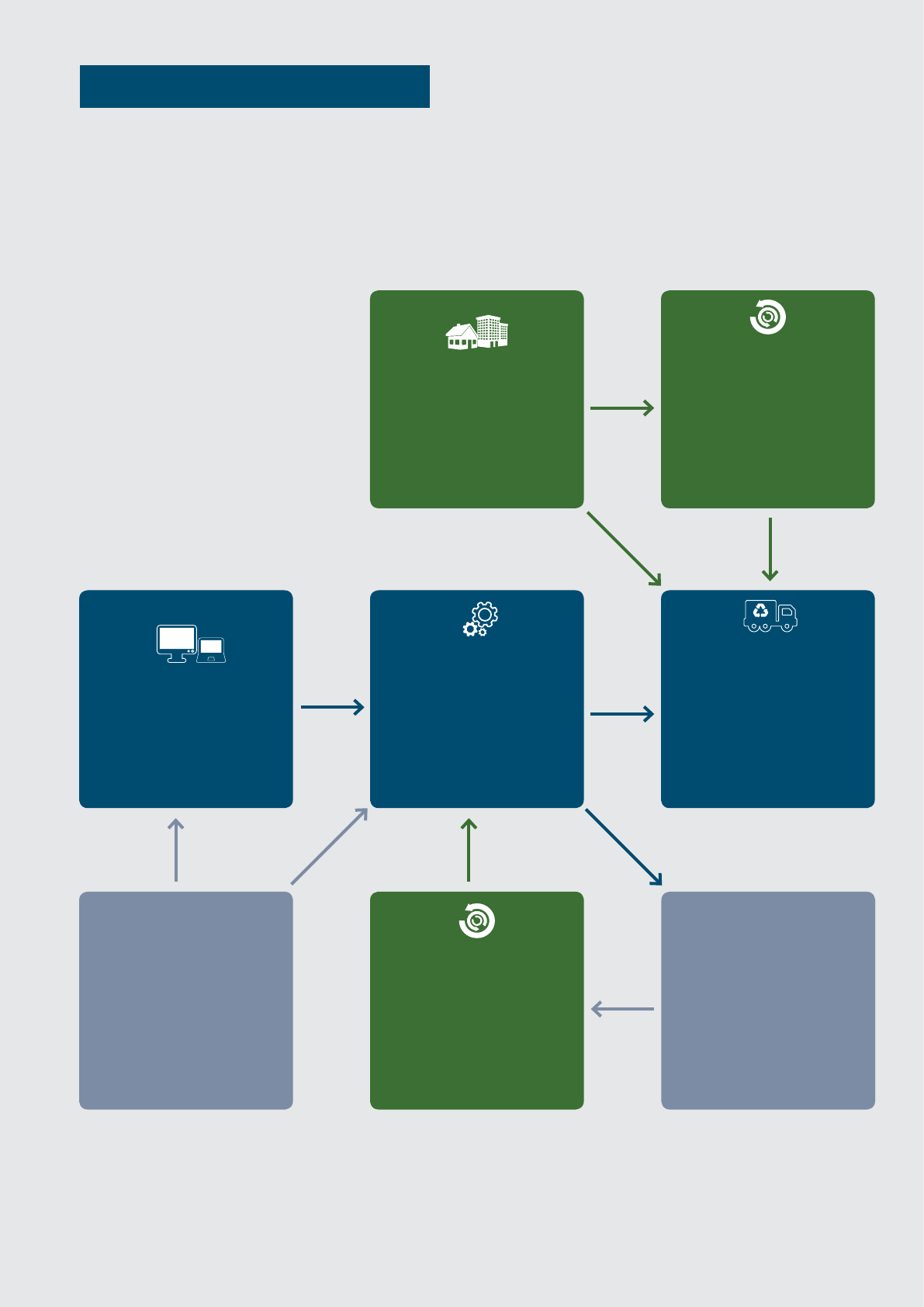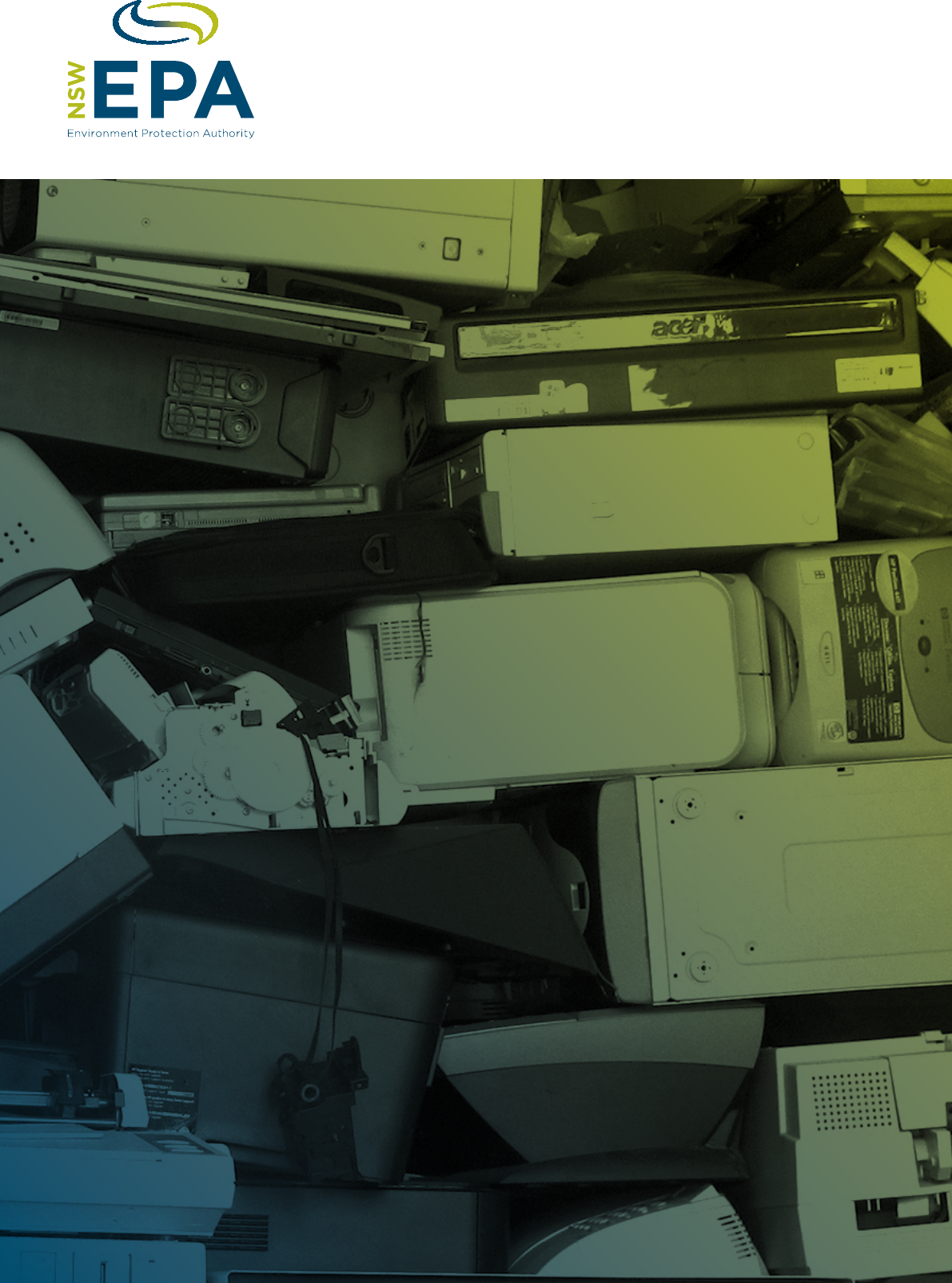
Contents
About this guide 3
About the National Television and Computer Recycling Scheme 4
» Aims of the recycling scheme 4
» How does the recycling scheme work? 4
» How is the scheme performing? 5
» Recent changes to the scheme 5
Roles and responsibilities 6
Tips for local councils, social enterprises and other stakeholders 7
» Establishing positive partnerships 7
» Managing the risks, roles and costs 8
» Community education and marketing 9
Which environmental laws cover e-waste? 10
» Waste must go to a lawful facility 10
» Classification of e-waste 11
» Transporting wastes 11
» Landfill disposal 11
» Accidental breakages 11
Other options for recycling e-waste 12
Funding possibilities 13
More information 14
» Australian Government NTCRS Regulator 14
» NTCRS co-regulatory arrangements 14
» Industry and community associations 14

Television and Computer Recycling in NSW 3
About this guide
This guide is for local councils, recyclers and other organisations who wish to
know more about television and computer recycling in New South Wales.
It provides some practical tips on:
» how to get good value and results from the Australian Government’s National
Television and Computer Recycling Scheme (NTCRS)
» how to avoid some of the pitfalls experienced by some local councils and
e-waste recyclers during the early years of the recycling scheme
» what to look for when negotiating an agreement with e-waste
service providers.
It also includes a brief summary of the NSW laws that apply to managing
e-waste and advice about e-waste recycling options outside the government-
funded scheme.
This is not a detailed legal guide to the Product Stewardship Act 2011
and Product Stewardship (Televisions and Computers) Regulations 2011.
Organisations wishing to offer services for recycling e-waste should obtain their
own independent legal and technical advice.

4 Environment Protection Authority
About the National Television and Computer
Recycling Scheme
The main mechanism for collecting and recycling television and computer
waste in Australia is the National Television and Computer Recycling Scheme
(NTCRS). This scheme is regulated by the Australian Government and has been
operating throughout Australia since 2011.
Under the scheme, Australian manufacturers and importers of televisions
and computers are required by law to share the responsibility and the cost of
recycling and disposal of these products. Most of the funding for the scheme
comes from the television and computer industry, with significant support from
local councils, retailers, social enterprise recyclers and other specialist waste
industry service providers.
Aims of the recycling scheme
The aims of the NTCRS are to:
» reduce waste going to landfill, especially the hazardous materials
found in e-waste
» increase recovery of reusable materials in a safe, scientific and
environmentally sound manner
» provide access for households and small businesses Australia wide
to an industry-funded recycling service.
How does the recycling scheme work?
Under the NTCRS, companies who manufacture or import televisions, printers
and computer products over a certain volume, are required to join an approved
co-regulatory arrangement or CA. The CAs work in cooperation with councils
and waste businesses to provide facilities and services for collecting and
recycling televisions and computers.
The CAs must collect and recycle an increasing proportion of the end-of-life
televisions and computers generated in Australia each year – rising from an
estimated 17% in 2010–11 to 80% by 2026–27. The remaining waste televisions
and computers, along with all other e-waste, is the responsibility of local, state
and territory governments.
All the parties involved – councils, the waste industry, e-waste specialists,
manufacturers and importers – need to work together cooperatively to deal
with the waste generated by discarded televisions and computers.
The CAs must meet a material recovery target of 90% of materials. The 90%
figure relates to the proportion of television and computer by-products which
must be sent, after recycling, for processing into usable products and materials.

Television and Computer Recycling in NSW 5
How is the scheme performing?
Throughout Australia, the NTCRS has driven an increase in recycling
infrastructure, e-waste recycling activities and community awareness. The
scheme has kick-started community collection events, permanent drop-off
sites and retailer support.
The Australian Government reports that over 130,000 tonnes of television and
computer waste has been recycled since the scheme began, with more than
1800 collection services provided to householders and small businesses.
However, there have been some negative outcomes for the scheme in New
South Wales. For example, the true cost of lawful recycling of some materials
was poorly understood by some of the new e-waste businesses. One of these
materials is television cathode ray tube (CRT) glass, which is costly to recycle
because it contains high levels of lead that can pose significant health and
environmental risks if not managed properly. This led to the stockpiling of
television CRT glass.
In 2014, the NSW Government responded with urgent funding of $1.5 million
to help recyclers deal with the stockpiled CRT glass. At the same time, the
NSW Government funded assessment of recycler’s business models to prevent
similar problems cropping up again.
The lessons from the early years of the scheme are now being used to help
deliver a more sustainable, community-friendly service that has measurable
environmental, social and economic benefits.
Recent changes to the scheme
The Australian Government recently reviewed the NTCRS in response to
problems raised by the recycling industry as well as some social enterprises,
local councils and state governments. As a result several changes have been
made to the scheme. These changes began on 1 July 2015 and include:
» revised recycling targets – starting at 50% in 2015–16 and rising to 58% in
2016–17, 62% in 2016–17 and reaching 80% in 2026–27
» certification – from 1 July 2016, recyclers and facilities will need to be
certified to Australian Standard AS/NZS 5377:2013 Collection, storage
transport and treatment of end-of-life electrical and electronic equipment.
In addition, the Australian Government will hold a more comprehensive review
of the operation of the scheme during 2016–17. This is required under the
Product Stewardship Act 2011.

6 Environment Protection Authority
Roles and responsibilities
Source: Adapted from the Australian Government, environment.gov.au/protection/
publications/infographic-roles-and-responsibilities-infographic
Liable parties
Required to join and fund
a co-regulatory arrangement
Scheme collection
services
Free of charge scheme
collection points for e-waste
May be permanent or
temporary. May be run
by councils, retailers,
or providers
E-waste recyclers
Contract with co-regulatory
arrangements to provide
recycling services
Work with other businesses
and local governments to
recycle e-waste outside
the scheme
Federal Department of
Environment
Ensures compliance of
liable parties
Ensures co-regulatory
arrangements meet
schedule outcomes
State and territory
governments
Environmental protection
authorities and other agencies
manage licensing and ensure
environmental and work health
and safety compliance
Oversee management of
e-waste outside the scheme
Monitor
outcomes
Transport
Disposal
Contract
E-Waste recyclers
Contract with co-regulatory
arrangements to provide
recycling services
Work with other businesses and
local governments to recycle
e-waste outside the scheme
Householders and
small businesses
Access to industry-funded
scheme e-waste collection
E-waste disposal outside of
scheme may incur a fee
Co-regulatory arrangement
administrators
Achieve scheme outcomes
for party members
Organise and advise public of
scheme collection and
recycling activities
Disposal
Ensure
compliance
Contract
Organise
services
Regulate
Fund

Television and Computer Recycling in NSW 7
Tips for local councils, social enterprises and
other stakeholders
Establishing positive partnerships
Developing positive and productive partnerships with all the parties that will be
involved in your collection and recycling program is one of the most important
aspects of managing e-waste.
The key to positive partnerships is discussion and clear communication from the
outset, and then regular contact with all parties involved.
This includes the relationships – formal and informal – that are developed
between councils, social enterprise recyclers and CAs. Partnerships based
on mutual benefits, clear objectives and agreed outcomes can provide the
foundation for an enduring e-waste collection and recycling service.
As with many large-scale programs, it’s important to avoid a ‘set-and-forget’
mode of operating. The partners will need to work together to identify and
implement ongoing improvements to the collection and recycling service.
n If your organisation is unsure about aspects of the NTCRS and what the various
parties’ obligations and requirements might be, contact the Australian Government
NTCRS Regulator (see ‘More information’ for contact details).
n Maintain a ‘paper trail’ at all times, to help ensure matching of expectations.
Formal written documentation and correspondence between all parties is
essential and reduces the risk of surprises and problems.
n Ask the CA to provide a single point of contact for all matters relating to your
participation in the NTCRS. This can help to resolve any issues and build a
strong relationship.
n Partnering with a CA needs to be a two-way process. Ensure you each identify and
clearly set out how you will manage potential challenges and risks as part of this
business relationship.
n Set regular progress meetings between your organisation and the CA and use
these to discuss what’s working well and to identify opportunities for improvement.
n Look beyond the current service provided by the CA and ask about their future
plans, especially in relation to how they will support your organisation with ongoing
publicity, marketing and community education.
n Given the current scope of the NTCRS is limited to television and computer
waste, ask the CA how they can assist with by-catch e-waste such as DVD
and VCR players, audio and hi-fi equipment, microwave ovens and other
consumer electronics.
n Look for opportunities to create partnership between CAs, schools, non-
government organisations and other community service organisations.
Tips

8 Environment Protection Authority
Managing the risks, roles and costs
Be very clear about who does what. This is particularly important because there
are several different parties involved in e-waste recycling.
Be wary of any CA or subcontractor resisting the need for formal written
agreements. Deals executed on the basis of ‘handshakes’ and ‘verbal
commitment’ have no legal or administrative standing and represent a
high-risk approach to managing television and computer waste.
Casual and informal ‘deals’ also leave councils and social enterprises exposed to
a multitude of issues including public liability, ad hoc withdrawal of collection and
recycling services, as well as breaching the governance requirements that most
organisations have in place.
A common concern expressed by many local councils is the one-sided nature of
contracts and agreements imposed by some CAs. Formal contracts or agreements
are essential but they need to be balanced, two-sided and mutually agreed.
Be clear on all the financial aspects of your organisation’s relationship with CAs.
You need to understand upfront exactly who will pay for what activities. With this
in mind you can assess whether the arrangement is fair and reasonable, typical,
and in the spirit of the NTCRS objectives and outcomes.
n Identify the risks associated with participating in the NTCRS and any partnerships.
Ensure this process is consistent with your organisation’s overall approach
to risk management.
n Formalise your participation in the NTCRS and ensure that any arrangements are
formally documented in an appropriate joint agreement. Most importantly, ensure your
agreement reflects a balanced approach to working cooperatively.
n If in doubt about any risks or concerns associated with your participation in
the NTCRS, and the relationship with your CA or their provider, seek clarification in writing.
n Based on issues experienced by some councils and social enterprises in New South Wales,
be sure to check on service agreements, termination clauses, volume limits and any other
CA requirements that might have financial implications for your organisation.
n Ask CAs about their quotas, volumes and targets and how these might impact
on your organisation’s collection and recycling activities.
n If you believe there may be some significant risks associated with being a collection or
recycling partner with a CA, seek advice and have contracts reviewed by a lawyer.
Take any resulting feedback to the CA for discussion and resolution.
n Check with other local councils to compare contracts or agreements and see how similar
organisations have managed the process. Learn from others’ mistakes and experiences.
n Ask for detailed information about downstream processes and processors and what
actually happens to the television and computer waste collected.
n Request support and training from the CA in relation to workplace health and safety
issues concerning the collection and recycling of television and computer waste from
your sites or community events.
Tips

Television and Computer Recycling in NSW 9
Community education and marketing
The success of any product recovery and recycling scheme depends on
effective and ongoing community education. A good community education
campaign is essential to raise awareness and maximise behaviour change
and participation.
Since it began, the NTCRS has slowly built a profile in the community, much of
this through promotion and advertising conducted by local council collection
partners. Some of the CAs are also investing in awareness-raising activities;
however, these can sometimes be about self-promotion rather than providing
comprehensive community education.
The NTCRS needs to fulfill ambitious collection and recycling targets over
the coming years. To achieve this the CAs will need to dedicate adequate
resources and funds for community education and marketing campaigns.
The community needs to understand the importance of recycling television
and computer waste, and know about drop-off locations and events.
Councils also need to make sure the community understands who is paying
for their e-waste recycling service. The CAs cover these costs in some areas,
but many councils fund and run their own e-waste recycling services for
householders. For the community, knowing how the service is being funded is an
important aspect of understanding how and why television and computer waste
is being managed by industry as well as local councils, social enterprises and
other service providers.
n Ask for a marketing and communications plan dedicated to your organisation’s
role in the NTCRS.
n Ensure your council’s intended approach for other e-waste is consistent with the
messaging for the NTCRS collections.
n Be very clear on the CA’s marketing and communications activities for your
organisation and associated events or site promotions.
n Make sure all parties clearly understand the respective roles and responsibilities
related to marketing, communications and education activities.
n Be clear on who will sign off on media releases. Make sure your organisation has
the opportunity to review, amend and approve any media releases as well as other
marketing and communication content such as social media content, blog posts, CA
webpages and similar channels.
n Ensure that all marketing and communication plus related activities, budgets, roles
and responsibilities are clearly set out in any contract or agreement between your
organisation and the CA and their providers.
n Where appropriate, use co-branding to reflect the contribution of your organisation.
n Discuss how the CA can support school education activities in your area, with a
view to building widespread community awareness about responsible e-waste recycling.
n Make sure your organisation’s financial and in-kind contributions to community
education aspects of the NTCRS are clearly documented by the CA in any
partnership agreement.
Tips

10 Environment Protection Authority
Which environmental laws cover e-waste?
The NTCRS is regulated by the Australian Government under the Product
Stewardship Act 2011 and the Product Stewardship (Televisions and
Computers) Regulations 2011.
In addition to the Product Stewardship Act and Regulations, all NTCRS
participants operating in New South Wales must also comply with relevant
NSW regulations.
In NSW, e-waste is managed as a ‘waste’ under the Protection of the
Environment Operations Act 1997 (the POEO Act) and the Protection of
the Environment (Waste) Regulation 2014 (the Waste Regulation). It is the
responsibility of businesses generating, storing, recycling, processing,
transporting or disposing of waste to be aware of all the regulatory
requirements that apply to their activities. NSW legislation is available at
legislation.nsw.gov.au.
The following summary outlines some basic requirements for dealing with
waste, but you should seek detailed independent advice about compliance.
Waste must go to a lawful facility
Waste must be transported to a facility that can lawfully accept that type of
waste. The POEO Act sets out significant penalties of up to $1,000,000 for
transporting waste to a place, or using a place as a waste facility, that cannot
lawfully be used for that waste.
Where relevant, the facility must also hold an environment protection licence
issued by the NSW Environment Protection Authority (EPA). An environment
protection licence can only be issued for sites that have development
consent from a consent authority (such as local council) for that activity. The
environment protection licence will set conditions, such as operating hours,
monitoring conditions and limits on the type and quantity of waste that can be
received at the site. Information on waste and resource recovery facilities that
are required to be licensed in NSW is available from the EPA website.
In general the EPA regulates licensed facilities and local councils regulate all
non-licensed facilities. If you are unsure about whether a site is a lawful waste
facility, contact your local council or the EPA.

Television and Computer Recycling in NSW 11
Classification of e-waste
All waste is classified according to the level of risk it poses to the environment
and human health.
In NSW, televisions, computers, printers and computer products received intact
and unprocessed by a waste facility are considered as ‘general solid waste
(non-putrescible)’. A facility will require an environment protection licence
if it receives general solid waste (non-putrescible) and exceeds specified
thresholds. Refer to Schedule 1 of the POEO Act for these thresholds.
In NSW, intact cathode ray tubes (CRTs) are classified as ‘general solid waste
(non-putrescible)’. However, if the tubes are crushed there is a risk of lead
leaching from the glass, so the glass is considered as a ‘hazardous waste’.
A NSW facility that receives crushed CRTs must comply with all requirements
relating to hazardous waste. Refer to Schedule 1 of the POEO Act for the
thresholds that apply to receiving hazardous waste.
Transporting wastes
Under the Waste Regulation, some wastes must be tracked when transported
into, within or out of New South Wales. To find out whether a waste must be
tracked, see the fact sheet Waste that must be tracked on the EPA website.
E-waste recyclers need to comply with these requirements.
If tracking is not required, general requirements for the transport of waste
apply. The waste consignor, transporter and receiving facility all have
obligations to ensure that waste is properly transported to a lawful facility.
Landfill disposal
All recycling and re-use opportunities should be considered before sending
waste to landfill.
In NSW, intact e-waste (whole TVs and CRTs) can be disposed of at landfills
that are licensed to receive that waste. However, hazardous waste such as
crushed CRT glass is prohibited from landfill disposal. Large amounts of intact
e-waste may also pose significant risks. Such waste may require treatment
such as ‘immobilisation’ before it can be disposed of at a licensed landfill. For
more information, see Waste immobilisation on the EPA website, and refer to
Part 2: The EPA Waste Classification Guidelines: Immobilisation of Waste.
Accidental breakages
Accidental breakages should be managed in line with NSW WorkCover
health and safety requirements and Australian Standard AS/NZS 5377:2013
Collection, storage, transport and treatment of end-of-life electrical and
electronic equipment. Based on this Standard, accidentally broken CRTs
should be managed safely, as if hazardous, and stored in a separate robust
container that is clearly labelled until it can be recycled or processed further.
More information is available from NSW WorkCover.

12 Environment Protection Authority
Other options for recycling e-waste
In addition to the co-regulatory arrangements operating under the NTCRS,
there are several other options for householders and small businesses who
wish to recycle e-waste. They include commercial fee-for-service providers, as
well as funded and subsidised initiatives.
There is a growing number of e-waste aggregators, dismantlers and recyclers
entering the market in New South Wales and nationally. These companies
provide a range of services and often focus on collection, re-use, remarketing
and recycling services for businesses, government agencies and institutions.
Some of these providers may be a viable option for some organisations,
especially where larger quantities are generated through company-wide
refresh programs and bulk volume asset disposal. In some cases, the services
provided include data destruction of associated media storage devices
including hard drives, tapes and discs.
However, it is important to ensure that any provider holds and complies with the
relevant certifications and licences needed to undertake the specified e-waste
processing and treatment. Find out if they have a valid NSW environment
protection licence by checking the EPA public register. It is vital that providers
have high levels of environmental performance, as well as robust workplace
health and safety practices.
When considering any collector, remarketer, dismantler or recycler of e-waste,
ask the following questions:
n Does the provider have an Environmental Management System that is independently
certified to ISO 14001?
n Do they operate in accordance with Australian Standard AS/NZS 5377:2013 Collection,
storage, transport and treatment of end-of-life electrical and electronic equipment?
n Are they independently audited to this Standard?
n Does the provider work to any other relevant standards such as the e-waste industry
R2 Standard?
n Is the provider certified to any other relevant standards such as ISO 9001 (Quality) or
AS/NZS 4801 and OHSAS 18001 (Occupational Health and Safety)?
n Does the provider hold any other type of environmental or sustainability certification,
quality mark, label or independent endorsement that indicates their commitment to,
and action, on responsible e-waste management?
It is always useful to seek references and talk with existing customers when
considering the engagement of a specialist e-waste management provider. Get to
know the business and how they operate so you can understand their processes and
level of environmental expertise.

Television and Computer Recycling in NSW 13
Funding possibilities
The demand for e-waste recycling services has exceeded the target
volumes anticipated for the NTCRS. This has resulted in some local councils
accumulating television and computer waste for which there are no external
funds to cover the recycling costs. It has also led to some CAs withdrawing
their funded collection and recycling services from councils and social
enterprises, nationally and in New South Wales.
The Australian Government sees this funding shortfall as a short- to medium-
term challenge. Increasing recovery targets combined with cost-effective
innovations are expected to help address this situation. However, councils,
businesses purchasing equipment and recyclers also need to think about
other options that could fund the growing demand for recycling television and
computer waste.
The following possibilities might be viable in the absence of a funded service:
» seek additional budget from internal sources to meet demand, or revert to
the e-waste recycling funding source used before the NTCRS was instigated.
» a fee-for-service approach could be applied, similar to other waste streams.
This could be managed through a cost-per-unit approach on a permanent
basis at waste transfer stations and recycling centres, or through dedicated
temporary events with a flat rate or ‘gate fee’.
» a fee-for-service approach could also be used for direct pick-ups booked
by residents, especially the elderly, the frail or those without access to
vehicular transport.
» organisations leasing or buying information technology in larger volumes,
should confirm the disposal and recycling options at the time of leasing
or purchasing. Several brands, manufacturers and business-to-business
distributors provide collection, re-use and recycling services as part of
their overall service to customers.
Check whether charges rule out participation in the NTCRS
The NTCRS is intended to provide a free e-waste recycling service to householders
and small businesses. Councils should seek advice from the regulator and CAs or
obtain their own legal advice if charges (to householders or small businesses) are
being considered. Charging a fee may mean the television and computer waste
cannot be accounted for as part of the NTCRS.

14 Environment Protection Authority
More information
For more information about the NTCRS contact
one of the organisations below. For enquiries
about how the scheme works or how to
participate, start with the Australian Government
NTCRS Regulator.
Australian Government
NTCRS Regulator
Australian Government Department of the
Environment: www.environment.gov.au/protection/
national-waste-policy/television-and-computer-
recycling-scheme
ewaste@environment.gov.au
Product Stewardship Line: phone 1800332783
NTCRS co-regulatory arrangements
Australia & New Zealand Recycling Platform
techcollect.com.au
MRI PSO
dropzone.org.au
E-Cycle Solutions
ecyclesolutions.net.au
Electronics Product Stewardship Australasia
epsaewaste.com.au
Industry and community associations
Australian Council of Recycling
acor.org.au
Community Recycling Network
communityrecycling.com.au
Waste Management Association of Australia
wmaa.asn.au
© 2016 State of NSW and Environment Protection Authority
With the exception of photographs, the State of NSW and
Environment Protection Authority are pleased to allow
this material to be reproduced in whole or in part for
educational and non-commercial use, provided the meaning
is unchanged and its source, publisher and authorship
are acknowledged. Specific permission is required for the
reproduction of photographs.
The Environment Protection Authority (EPA) has compiled
this guide in good faith, exercising all due care and
attention. No representation is made about the accuracy,
completeness or suitability of the information in this
publication for any particular purpose. The EPA shall not be
liable for any damage which may occur to any person or
organisation taking action or not on the basis of this
publication. Readers should seek appropriate advice when
applying the information to their specific needs. This
document may be subject to revision without notice and
readers should ensure they are using the latest version.
This Guide has been published and funded by the NSW EPA,
and was authored by Infoactiv Australia. The opinions and
views expressed in the Guide are those of the author and not
necessarily those of the NSW EPA.
© Infoactiv Australia and NSW EPA: All rights reserved.
Infoactiv Australia Pty Ltd
Tel: 1800 489 278
Published by:
Environment Protection Authority
59 Goulburn Street, Sydney NSW 2000PO Box A290,
Sydney South NSW 1232
Phone: +61 2 9995 5000 (switchboard)
Phone: 131 555 (NSW only – environment information and
publications requests)
Fax: +61 2 9995 5999
TTY users: phone 133 677, then ask for 131 555
Speak and listen users: phone 1300 555 727, then ask
for 131 555
Email: info@environment.nsw.gov.au
Website: www.epa.nsw.gov.au
Report pollution and environmental incidents
Environment Line: 131 555 (NSW only) or
info@environment.nsw.gov.au
See also www.epa.nsw.gov.au
ISBN 978-1-76039-435-6 EPA 2016/0449
August 2016

